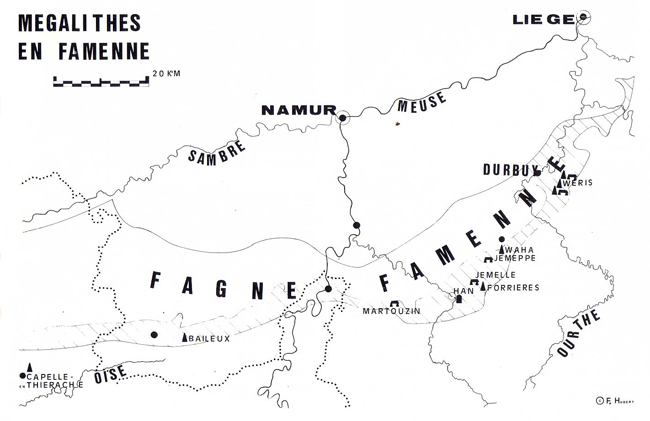Dating
The Wéris Megaliths are geographically located in High Belgium on a narrow limestone strip called The Calestienne. This is a limestone plateau some 130 Kms long by between 2 and 4 Kms wide.
This plateau runs from the French border near Chimay in the west, in a north-easterly direction towards Louveigné in the east. The Calestienne forms the transition between the Lower Famenne Depression in the north and the Ardennes in the south.
About 5000 years ago, in the late Neolithic Period, the culture in northern France (in the Paris Basin) and southern Belgium was named after the rivers, Seine, Oise and Marne and was referred to as the SOM Culture. It existed from around 3100 BC until 2500 BC.
In the beginning of the third millennium BC, some of these Neolithic SOM people migrated north and established settlements in what is now southern Belgium; particularly in the Calestienne and the Fagne/Famenne Depression, but also in the valleys of the rivers Meuse and Sambre and, to a lesser extent in Flanders and the southern Netherlands. The Ardennes were within reach of the SOM cultural area but outside that of the Funnel Beaker culture. The Dutch branch of the Funnel Beaker culture was part of the West Group. The people of the Dutch branch built hunebedden in their region in what is now Drenthe, Groningen and adjacent Lower-Saxony. In the remains of these hunebedden some funnel-shaped ceramic cups have been found.
In Wallonia, no remnants of houses of the SOM population have been found, but the remains that provide evidence of their communities in Wallonia are their spectacular tombs. It is these that are known as dolmens – large stone burial structures. Evidence has been found that these burial sites were in use during different periods.
At the same time as using dolmens or gallery graves, burials were also carried out in caves as during the Mesolithic Period, and in marchets which are stone-built burial mounds.
The pottery of the SOM Culture was coarse, thick-sided with heavy bases, and was rudimentary in form having an S-shaped profile without any embellishment.

The dolmen of Wéris (Wéris I) and the dolmen of Oppagne (Wéris II) are collective gallery graves. They are the final resting places of some of the SOM Culture population. Very little archeological material was found during excavations, but the burial activity is confirmed. Carbon-dating of bones place them in the third millennium BC, more specifically between 3000 and 2800 BC. The dolmens and menhirs are of the same period.






